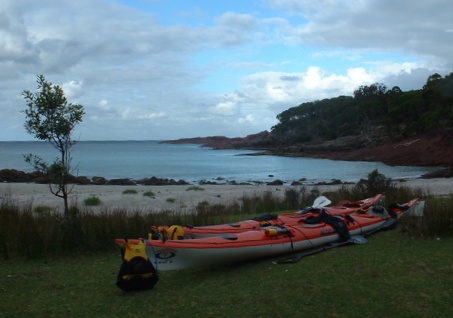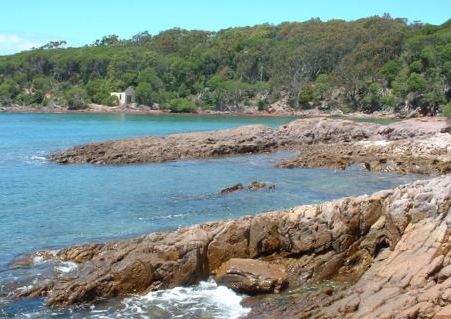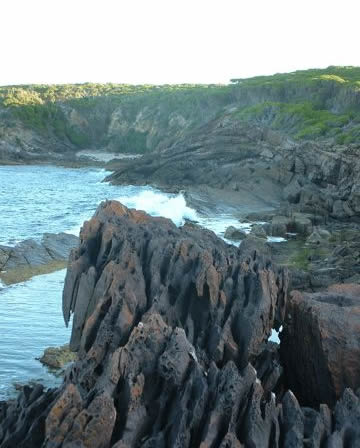Sea kayak Adventures South of Eden
by Dave Baldwin, December 2004
After Christmas Julie and I were keen to get some paddling done in our double sea kayak. Our initial thought was to head down Eden way, maybe even try to go from Eden to Mallacoota. We convinced Andrew Rowe and Nicky Thatcher to come along too. We arranged to leave from Eden on December 29. Closer to the time Andrew and Nicky had to cut back their time to only one night away, and the traditional storm for the Sydney-Hobart yacht race was still blowing itself out, so conditions were shaping up to be a bit rough and windy. Our plans were scaled back a bit and we decided to base our trip out from Eden south along the Ben Boyd NP coast and possibly beyond.
Starting from Corara Beach in Eden
Lunchtime on Dec 29 saw us packed up and ready to go at Corara Beach in Eden after dodging a few rain showers while we got ready. There were at least a dozen Sydney-Hobart yachts in Eden harbour, so we started off having a look around at them before heading across Twofold Bay to Kiah Inlet. Soon after we cleared the breakwater heading across the bay, we saw a dis-masted race yacht motoring in to the harbour. As we crossed the bay a small rain squall beat down on us, but fortunately it soon cleared.
The tide was running strongly out of Kiah Inlet, but some hard paddling
got us around the corner into the lagoon behind the sand bar where we
stopped for a break. It was a beautiful sunny afternoon and really calm
in the sheltered waters on the south side of the bay. We were planning
on heading out through the heads and around the corner to find a
campsite, so we headed back out of the inlet and around the corner past
the Naval pier and the massive woodchip bulk-loader. We could smell the
tortured souls of all the trees that had been smashed up there, and as
we paddled under the mussell-encrusted piles of the conveyor jetty we
could sense the siege atmosphere with barbwire topped chain link fences
surrounding the site. We rounded the head and left the shameful place,
heading past Boyd's Tower on Red Point, a standing memorial to a 19th
century entrepeneur who aspired to make the area a commercial hub, but
went broke within 5 years. The impressive deep red twisted and folded
rocks of the cliffs unrolled ahead of us, and we had to work fairly
solidly into a rolling swell.
At the next headland we threaded the gap between the point and an offshore rock. The shallow waters piled the waves up higher to around 4-5m high, but fortunately not steep. This was a bit nerve-wracking for the forward paddlers Nicky and Julie though, who don't have any control of the boat's steering (the rudder is controlled by the rear paddler), and are the ones who take more of the brunt of the waves heading into the swell.
Around the point we checked out Leatherjacket Bay which is a bushwalking campsite, but the boulder beach meant we couldn't land, so on we went towards Mowarry Beach. Tucked inside a long rocky finger is a sheltered bay with two beaches which are sheltered from southerly winds and swell. We cruised in to Farm Cove at the head of the bay and a small beach framed by rocks with a small creek running in behind the beach. The swell was about 10cm, so landing was easy despite the rocks. Our campsite for the night was on a grassy terrace behind the beach - perfect, but for the infestation of mosquitoes which drove us into our tents by dark. |
 |
Campsite at Farm Cove |
The next morning Andrew and Nicky headed back to Eden, but we continued
on southwards. We were aiming for lunch at Bittangabee bay, and then if
we were making good progress, possibly camping at Merrica River around
Green Cape and across Disaster Bay. Our first landmark was rounding
Mowarry Head - at which point the Green Cape lighthouse came into view,
about 15km away. Saltwater Creek was our morning tea break, and we
successfully rounded the rolling surf on the rocky break at the south
end of the beach and landed at the outlet of a large creek. After a
stroll along the length of the beach, we launched off the beach and out
through the waves again and headed on south. The sea was very lumpy with
lots of reflected waves from the cliff, and after around 30 mins Julie
had to reach for her bailer and lost her breakfast over the side.
We looked in on Hegarty Bay, another bushwalker's campsite, but it also had a rocky beach so not suitable for landing. Bittangabee Bay was not much further down the coast, and is beautifully sheltered at the back of the bay, with a narrow entrance between the heads and then a rocky bar soaking up the swell. A welcome relief from the queasiness of the open sea. The bay was used as the supply depot for building materials for the Green Cape lighthouse approx 7km south which were transported by a horse-drawn tramway on rails cut from local logs in the 1870s. After the lighthouse was constructed, food and other supplies were dropped in the storage shed in the bay, the ruins of which can still be seen (see photo at left).
Bittangabee Bay
We ate our lunch on a low rocky point while young families played on the beach nearby. There is a very popular campsite in the scrub above the shed ruins. After lunch we continued south, but the breeze had freshened up to around 15 knots and we were making slow progress. After half an hour we were barely a quarter of the way to Green Cape, and the breeze was still freshening with white caps starting to form. There was no need to flog ourselves for the next 5 hours, and who knows what conditions would be like around Green Cape in Disaster Bay, so we happily turned around and headed back to Bittangabee to pick up water at the head of the bay and then find a campsite. Luckily there was a vacant site, so we spent a mellow afternoon setting up camp then exploring the area. The picture is taken from the headland looking south - a popular spot with fishermen.
 The next morning the wind had dropped so we made good progress down the
coast past Pulpit Rock to Green Cape. The swell was still quite high at
2-4m with other waves reflected of the cliffs rolling back and forth. As
we drew abreast of the lighthouse at last, we saw a grey dorsal fin
about 20m away inshore. This was no dolphin, and there was a tail
The next morning the wind had dropped so we made good progress down the
coast past Pulpit Rock to Green Cape. The swell was still quite high at
2-4m with other waves reflected of the cliffs rolling back and forth. As
we drew abreast of the lighthouse at last, we saw a grey dorsal fin
about 20m away inshore. This was no dolphin, and there was a tail
visible too about 1.5m behind the fin, the shark just cruising on the
surface. We veered away, but a minute or so later saw another collection
of fins in the water just ahead. There were four of them - blacker and a
bit droopy looking, but we weren't hanging around to find out what they
were!
We finally got beyond the rocky reef at the end of the cape into the smoother ocean swell and could see across Disater Bay to Nadgee Nature Reserve and south to Cape Howe and the Victorian border. After admiring the view we did a wide turn out to sea and headed back to Bittangabee for a break, then on to Saltwater Creek for lunch. The breeze was now from the NE, and there were waves coming more into the corner of the beach. As we launched off the beach after lunch and headed out, we copped a big wave which swung us around and the next rolled us over, swamping the boat and washing us back onto the beach. The boat was full of water, and our electric pump seemed to have packed up, so we spent 5 mins bailing out using the trusty cut-off 2l milk bottle bailers. Our second attempt got us successfully past the break, and we worked our way back around Mowarry Point with the aim of staying a second night at our outbound campsite.
The NE breeze was rolling waves of 50cm and higher into the bay and the tide was quite low, but we headed into the beach regardless. About 100m offshore a wave came it behind and shot us forward. About 50m offshore we slewed to one side off the front of the wave, which then flipped us over. Julie and I both clung to our paddles while the wave carried the boat in, and the leashes snapped as the distance opened up. We were now left clutching our paddles, which we could not afford to let go of now, in chest deep water with the boat heading towards to rocks! Fortunately I was able to touch the bottom and managed to grab the boat before another wave battered it on the rocks. A boat full of water is extremely heavy and unmanouevreable. We finally got it onto the beach without any damage, and retrieved my hat which was floating in the waves.
There was a bunch of people up at the campsite already. One guy walked down and helped us with the boat and made a comment about shipwrecked sea kayakers. A few years ago in Croajingalong he had seen a sea kayak smashed on the rocks! We felt pretty lucky to be all in one piece. Julie and I had a brief discussion about our options - staying or heading on to Eden. We had no idea what the wind was going to do, but if it freshened more we might be stuck on the beach, possibly having to walk out and hitch back to the car and then carry the boat and all our stuff out. We decided we were too stuffed to paddle any further though since we'd already done about 30km, and it was another 20km to Eden.
We carried our gear up to the campsite and dumped it on the grass. After our last load we asked the group where they were planning on putting their tents up. At this point one guy started giving us a hard time about "crashing their party" - it was New Year's Eve - and insisted we go somewhere else. It turned out he hadn't seen our dramatic entry, but he still wasn't happy. We dragged out gear to the far end of the grassy terrace, set up our tent and stayed out of their way the rest of the time we were there. After unpacking we decided to walk to Mowarry Head along the coastal walking track - the picture below is from near the point looking back to the bay the campsite was in, just beyond the rocky finger.
By the time we got back we were pretty stuffed and had an early dinner then went to bed. At least the breeze was keeping the mosquitoes away. It was hard to get to sleep though with the sounds of the wind blowing and the waves crashing on the beach, and thoughts of what we might face in the morning.
Farm Cove to Eden
We were up the next morning by 6:30am and packed our gear away. The waves were still as bad, but at least weren't any worse. The rocks on the beach would eventually be covered by the rising tide, but that would mean waiting hours until around noon. There was a southerly change forecast for the afternoon which might flatten the waves, but would probably make things pretty interesting once we got offshore. By 8am the boat was all packed up and we considered our options. We finally decided to give it a try, but with the electric pump dead and only hand bailers as backup it was a scary prospect. We floated the boat and walked it into the calmest part of the bay standing knee-deep in the water. Julie hopped in and fastened her spray deck down. I jumped into my cockpit and we paddled hard. A wave started building up in front of us and I thought we were gone, but we sliced through it and I only took a bit of water in my end, then we were beyond the break. A big relief! I fastened my spraydeck down then it was a relatively stress-free paddle along the coast across the swell into Twofold Bay. Once into the bay the sea flattened out totally and the wind dropped away - it was quite an anti-climax paddling across to Eden.
In the middle of the bay we came across a seal lolling on its side with two flippers in the air, and realized the second encounter at Green cape was a pair of seals - possibly about to become a shark's lunch though! By 10am we reached Corara Beach again, and were packed up and enjoying fish and chips on Eden wharf by 11:30. After a coffee we headed to the Killer Whale Museum. There was a model of a 3.5m Mako Shark which looked eerily similar to what we'd seen at Green cape...
Quite a trip! Lots of adventure, and we now know what we need to know for next time! Our boat is also now ensconced in the ANU boat shed, so morning, lunch or evening paddling sessions are a possibility in the far safer environs of Lake BG.


